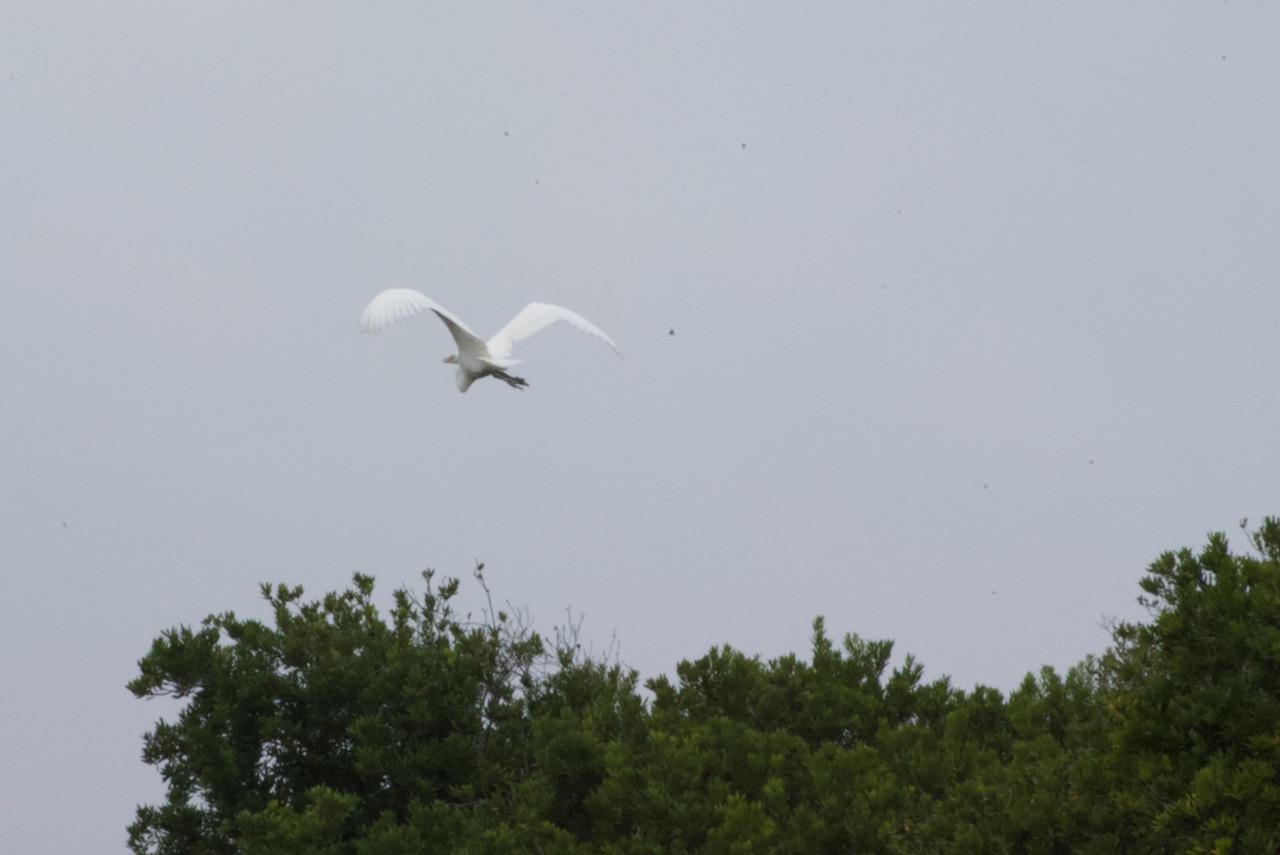
White Heron by John Ciardi
What lifts the heron leaning on the air
I praise without a name. A crouch, a flare,
a long stroke through the cumulus of trees,
a shaped thought at the sky — then gone. O rare!
Saint Francis, being happiest on his knees,
would have cried Father! Cry anything you please
But praise. By any name or none. But praise
the white original burst that lights
the heron on his two soft kissing kites.
When saints praise heaven lit by doves and rays,
I sit by pond scums till the air recites
It’s heron back. And doubt all else. But praise.
The person who called was standing at the Eureka waterfront, near the Adorni Center, when she watched a Great Egret come swimming across the channel that separates the shoreline there from Woodley Island. The ordinarily elegant and beautiful white bird clambored out of the water up onto the riprap and hunkered down, apparently exhausted.
Catching the Egret wasn’t that hard. A bedraggled big white bird sitting on rocks is easy to spot, and their exhaustion left them unable to flee when approached. Once captured, it was obvious that this was a juvenile Egret, – this year’s model, who’d probably come into this world just two islands over on Tuluwat, which hosts a large heronry each Spring and Summer.
After getting them back to the clinic, we first provided a warm environment to help with hypothermia, and administered warmed fluids both to help warm the egret as well as to begin rehydrating the seriously depleted bird.
Within a few hours the bird was standing and very pleased to discover the fish that we’d put in their housing with them. For piscivores in trouble, fish is a big part of the solution.
For many patients, a small sample of blood can reveal a lot about their condition. Spinning the sample in a centrifuge separates the blood into cells and plasma, revealing the percentage that is red blood cells. This number is often called the “packed cell volume” or PCV. Red blood cells carry the oxygen that is part of the fuel of life – the lower the PCV, the more anemic the patient. While there is some variation across the many species we treat, for aquatic birds, a PCV of 40 (that is to say that red blood cells make up 40% of the total sample) is considered a baseline of good health. This Egret’s first sample on admission revealed a critically low PCV of 17%. Considering the severity of the bird’s dehydration, it’s safe to say that the actual percentage of red blood cells would be even lower one the patient is rehydrated.
Still, this number didn’t really change the care we offered (warmth, fluids, fish and safety), but it did let us know how close to death the young Egret had come.
After a few days, of hydration and food, the Egret’s PCV had climbed above 20 and they were able to make short evasive flights in the aviary when we would capture for regular exams and weight checks. After 8 days in care the PCV had recovered another 10 points and stood at 30%. After a couple weeks, the Egret was flying beautifully – their PCV was back within normal limits, their weight had increased from 679 grams in admission to 1117 grams – a 160% gain! They looked really good. It was time for release.













Even though many of our patients are injured traumatically, or have become so sick and debilitated that there isn’t anythng we can do to help, and even through the frustrations of living in a human society that casually hinders, harms and destroys wild lives, providing care for the wild, the innocent, provides a wonderful close view of the miracle of healing, the mystery of hunger, and the fulfillment of dreams. This Egret was an astonishing patient. Your support bought the fish, the fluids, the safe space, the net and the gasoline for the rescue, as well as paid for the trained and dedicated staff needed to deliver it all in an effective manner. Thank you for making sure this Great Egret had somewhere and someone who could help them with a second chance.
This is a crucial time in our history, and as we prepare to move our facility to a location that will give us something more stable and sustainable we need your help badly! If you can, please DONATE today
Thank you for making the difference all of our patients need.

all photos: Laura Corsiglia/BAX

